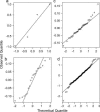Bias and precision in QST estimates: problems and some solutions
- PMID: 16085700
- PMCID: PMC1456852
- DOI: 10.1534/genetics.105.044545
Bias and precision in QST estimates: problems and some solutions
Abstract
Comparison of population differentiation in neutral marker genes and in genes coding quantitative traits by means of F(ST) and Q(ST) indexes has become commonplace practice. While the properties and estimation of F(ST) have been the subject of much interest, little is known about the precision and possible bias in Q(ST) estimates. Using both simulated and real data, we investigated the precision and bias in Q(ST) estimates and various methods of estimating the precision. We found that precision of Q(ST) estimates for typical data sets (i.e., with <20 populations) was poor. Of the methods for estimating the precision, a simulation method, a parametric bootstrap, and the Bayesian approach returned the most precise estimates of the confidence intervals.
Figures






References
-
- Bayarri, M. J., and J. O. Berger, 2004. The interplay of Bayesian and frequentist analysis. Stat. Sci. 19: 58–80.
-
- Brooks, S. P., and A. Gelman, 1998. Alternative methods for monitoring convergence of iterative simulations. J. Comput. Graph. Stat. 7: 434–455.
-
- Cano, J. M., A. Laurila, J. Palo and J. Merilä, 2004. Population differentiation in G matrix structure in response to natural selection in Rana temporaria. Evolution 58: 2013–2020. - PubMed
-
- Crnokrak, P., and J. Merilä, 2002. Genetic population divergence: markers and traits. Trends Ecol. Evol. 17: 501.
-
- Davison, A. C., and D. V. Hinkley, 1997. Bootstrap Methods and Their Applications. Cambridge University Press, Cambridge, UK.
Publication types
MeSH terms
LinkOut - more resources
Full Text Sources
Miscellaneous

